United States Armed Forces
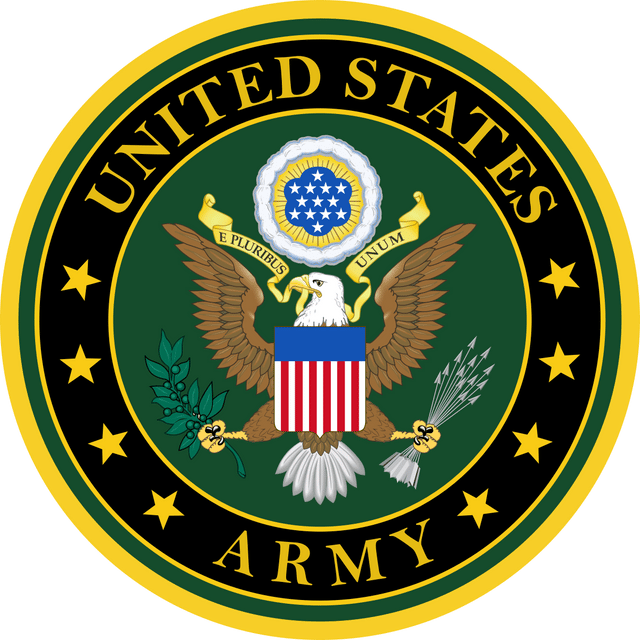
United States Armed Forces

| United States Armed Forces | |
|---|---|
     Seals of the five service branches | |
| Founded | 14 June 1775 (1775-06-14)[1] |
| Service branches | |
| Headquarters | The Pentagon, Arlington County, Virginia |
| Leadership | |
| Commander-in-Chief | |
| Secretary of Defense | |
| Secretary of Homeland Security | |
| Chairman of the Joint Chiefs of Staff | |
| Vice Chairman of the Joint Chiefs of Staff | |
| Senior Enlisted Advisor to the Chairman | |
| Manpower | |
| Military age | 17 with parental consent, 18 for voluntary service.[2] |
| Conscription | Male only (inactive since 1973) |
| Available for military service | 17 million[6], age 18–25 (2016) |
| Reaching military age annually | 2 million[7] (2016) |
| Active personnel | 1,374,699 [8] (ranked 3rd) |
| Reserve personnel | 845,600[9] |
| Deployed personnel | 210,000 |
| Expenditures | |
| Budget | US$693 billion (2019)[10] (ranked 1st) |
| Percent of GDP | 3.42% (2019)[11] |
| Industry | |
| Domestic suppliers | List |
| Related articles | |
| History | Military history of the United States List of engagements American Revolutionary WarWhiskey Rebellion Indian Wars Barbary Wars War of 1812 Patriot War Mexican–American War Utah War Cortina Troubles Reform War American Civil War
Spanish–American War Banana Wars Philippine–American War Boxer Rebellion Border War World War I Russian Civil War World War II Cold War
Somali Civil War
Pakistan–United States skirmishes Other |
| Ranks | Commissioned officer
|
The United States Armed Forces[12] are the military forces of the United States of America. It consists of the Army, Marine Corps, Navy, Air Force, and Coast Guard.[13] The president of the United States is the commander-in-chief of the Armed Forces and forms military policy with the Department of Defense (DoD) and Department of Homeland Security (DHS), both federal executive departments, acting as the principal organs by which military policy is carried out. All five armed services are among the seven uniformed services of the United States.[14]
From the time of its inception, the U.S. Armed Forces played a decisive role in the history of the United States. A sense of national unity and identity was forged as a result of victory in the First Barbary War and the Second Barbary War. Even so, the founders of the United States were suspicious of a permanent military force. It played a critical role in the American Civil War, continuing to serve as the armed forces of the United States, although a number of its officers resigned to join the military of the Confederate States. The National Security Act of 1947, adopted following World War II and during the Cold War's onset, created the modern U.S. military framework. The Act established the National Military Establishment, headed by the secretary of defense; and created the Department of the Air Force and the National Security Council. It was amended in 1949, renaming the National Military Establishment the Department of Defense, and merged the cabinet-level Department of the Army, Department of the Navy, and Department of the Air Force, into the Department of Defense.
The U.S. Armed Forces are one of the largest militaries in terms of the number of personnel. It draws its personnel from a large pool of paid volunteers. Although conscription has been used in the past in various times of both war and peace, it has not been used since 1973, but the Selective Service System retains the power to conscript males, and requires that all male citizens and residents residing in the U.S. between the ages of 18–25 register with the service.[15] On February 22, 2019, however, a federal judge ruled that registering only males for Selective Service is unconstitutional.
As per Credit Suisse, the U.S. Armed Forces are the world's most powerful military.[16] As of 2019, the U.S. spends US$693 billion to fund its armed forces mandatory and discretionary accounts.[17] As of 2018, the U.S. constitutes roughly 36 percent of the world's military expenditures. The U.S. Armed Forces has significant capabilities in both defense and power projection due to its large budget, resulting in advanced and powerful technologies which enables a widespread deployment of the force around the world, including around 800 military bases outside the United States.[18] The U.S. Air Force is the world's largest air force, the U.S. Navy is the world's largest navy by tonnage, and the U.S. Navy and the U.S. Marine Corps combined are the world's second largest air arm. In terms of size, the U.S. Coast Guard is the world's 12th largest naval force.[19][20][21] The U.S. as of FY2019 has about 14,061 aircraft in inventory.[22]
| United States Armed Forces | |
|---|---|
     Seals of the five service branches | |
| Founded | 14 June 1775 (1775-06-14)[1] |
| Service branches | |
| Headquarters | The Pentagon, Arlington County, Virginia |
| Leadership | |
| Commander-in-Chief | |
| Secretary of Defense | |
| Secretary of Homeland Security | |
| Chairman of the Joint Chiefs of Staff | |
| Vice Chairman of the Joint Chiefs of Staff | |
| Senior Enlisted Advisor to the Chairman | |
| Manpower | |
| Military age | 17 with parental consent, 18 for voluntary service.[2] |
| Conscription | Male only (inactive since 1973) |
| Available for military service | 17 million[6], age 18–25 (2016) |
| Reaching military age annually | 2 million[7] (2016) |
| Active personnel | 1,374,699 [8] (ranked 3rd) |
| Reserve personnel | 845,600[9] |
| Deployed personnel | 210,000 |
| Expenditures | |
| Budget | US$693 billion (2019)[10] (ranked 1st) |
| Percent of GDP | 3.42% (2019)[11] |
| Industry | |
| Domestic suppliers | List |
| Related articles | |
| History | Military history of the United States List of engagements American Revolutionary WarWhiskey Rebellion Indian Wars Barbary Wars War of 1812 Patriot War Mexican–American War Utah War Cortina Troubles Reform War American Civil War
Spanish–American War Banana Wars Philippine–American War Boxer Rebellion Border War World War I Russian Civil War World War II Cold War
Somali Civil War
Pakistan–United States skirmishes Other |
| Ranks | Commissioned officer
|
History
The history of the U.S. Armed Forces dates to 14 June 1775, with the creation of the Continental Army, even before the Declaration of Independence marked the establishment of the United States. The Continental Navy, established on 13 October 1775, and Continental Marines, established on 10 November 1775, were created in close succession by the Second Continental Congress in order to defend the new nation against the British Empire in the American Revolutionary War.
These forces demobilized in 1784 after the Treaty of Paris ended the War for Independence. The Congress of the Confederation created the current United States Army on 3 June 1784. The United States Congress created the current United States Navy on 27 March 1794 and the current United States Marine Corps on 11 July 1798. All three services trace their origins to their respective Continental predecessors. The 1787 adoption of the Constitution gave the Congress the power to "raise and support armies", to "provide and maintain a navy" and to "make rules for the government and regulation of the land and naval forces", as well as the power to declare war. The president is the U.S. Armed Forces' commander-in-chief.
The United States Coast Guard traces its origin to the founding of the Revenue Cutter Service on 4 August 1790 which merged with the United States Life-Saving Service on 28 January 1915 to establish the Coast Guard. The United States Air Force was established as an independent service on 18 September 1947; it traces its origin to the formation of the Aeronautical Division, U.S. Signal Corps, which was formed 1 August 1907 and was part of the Army Air Forces before becoming an independent service as per the National Security Act of 1947. The United States Public Health Service Commissioned Corps was formerly considered to be a branch of the United States Armed Forces from 29 July 1945 until its status as such was revoked on 3 July 1952.[23]
Space Force proposal
On March 1, 2019, the Department of Defense sent a proposal to Congress that would establish the United States Space Force as an independent military service within the Department of the Air Force. If approved, this would become the sixth military service branch to be created.[24]
Command structure
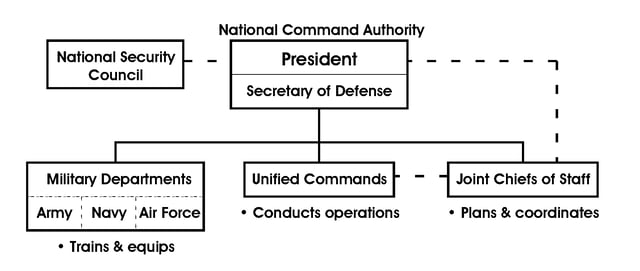
Structure of the National Command Authority
Command over the U.S. Armed Forces is established in the Constitution. The sole power of command is vested in the president by Article II as commander-in-Chief. The Constitution presumes the existence of "executive Departments" headed by "principal officers", whose appointment mechanism is provided for in the Appointments Clause. This allowance in the Constitution formed the basis for creation of the Department of Defense in 1947 by the National Security Act. The DoD is headed by the secretary of defense, who is a civilian and member of the Cabinet. The defense secretary is second in the U.S. Armed Forces chain of command, with the exception of the Coast Guard, which is under the secretary of homeland security, and is just below the president and serves as the principal assistant to the president in all defense-related matters.[25] Together, the president and the secretary of defense comprise the National Command Authority, which by law is the ultimate lawful source of military orders.[26]
To coordinate military strategy with political affairs, the president has a National Security Council headed by the national security advisor. The collective body has only advisory power to the president, but several of the members who statutorily comprise the council (the secretary of state, the secretary of energy and the secretary of defense) possess executive authority over their own departments.[27]
Just as the president, the secretary of defense, and the secretary of homeland security, are in charge of the entire military establishment, maintaining civilian control of the military, so too are each of the Defense Department's constitutive military departments headed by civilians. The four DoD branches are organized into three departments, each with civilian heads. The Department of the Army is headed by the secretary of the Army, the Department of the Navy is headed by the secretary of the Navy and the Department of the Air Force is headed by the secretary of the Air Force. The Marine Corps is organized under the Department of the Navy, however it is still considered a separate and equal service. The Coast Guard is under the Department of Homeland Security and receives its operational orders from the secretary of homeland security. However, the Coast Guard may be transferred to the Department of the Navy by the president or Congress during a time of war, thereby placing it within the DoD.[28]
The president, secretary of defense and other senior executive officials are advised by a seven-member Joint Chiefs of Staff, which is headed by the chairman of the Joint Chiefs of Staff, the highest-ranking officer in the United States military and the vice chairman of the Joint Chiefs of Staff.[29] The rest of the body is composed of the heads of each of the DoD's service branches (the chief of staff of the Army, the chief of naval operations, the commandant of the Marine Corps and the chief of staff of the Air Force) as well as the chief of the National Guard Bureau. Although commanding one of the five military branches, the commandant of the Coast Guard is not a member of the Joint Chiefs of Staff. Despite being composed of the highest-ranking officers in each of the respective branches, the Joint Chiefs of Staff does not possess operational command authority. Rather, the Goldwater-Nichols Act charges them only with advisory power.[30]
All of the branches work together during operations and joint missions in Unified Combatant Commands, under the authority of the secretary of defense with the typical exception of the Coast Guard. Each of the Unified Combatant Commands is headed by a combatant commander, a senior commissioned officer who exercises supreme command authority per 10 U.S.C. § 164 [73] over all of the forces, regardless of branch, within his geographical or functional command. By statute, the chain of command flows from the president to the secretary of defense to each of the combatant commanders.[31] In practice, the chairman of the Joint Chiefs of Staff often acts as an intermediary between the secretary of defense and the combatant commanders.
Budget
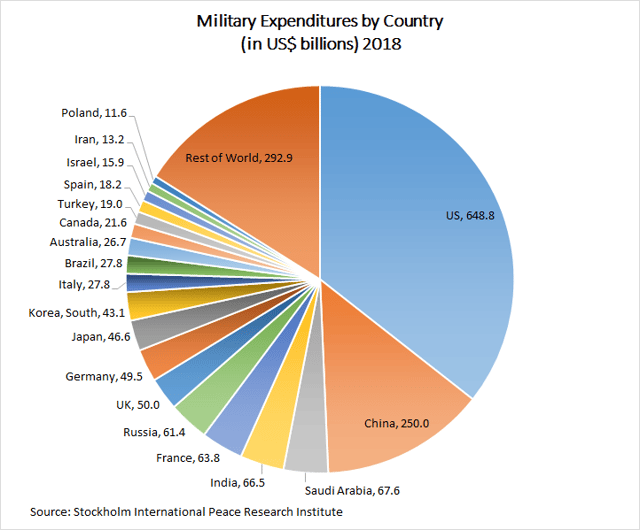
A pie chart showing global military expenditures by country for 2018, in US$ billions, according to SIPRI
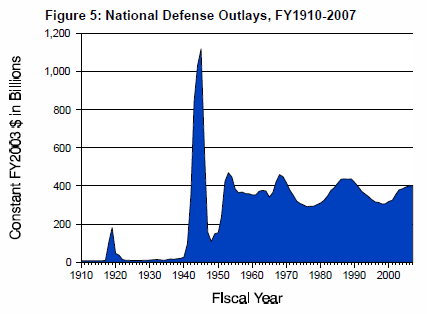
U.S. military spending from 1910 to 2007, adjusted for inflation to 2003 dollars; the large spike represents World War II spending.
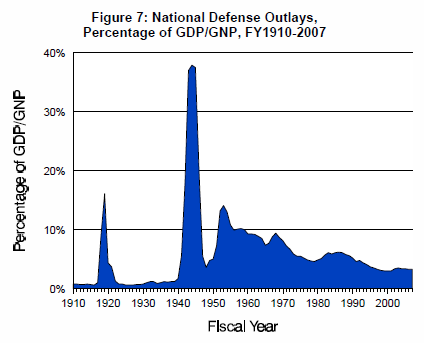
American defense spending by GDP percentage 1910 to 2007
The United States has the world's largest military budget. In the fiscal year 2019, $693 billion in funding were enacted for the DoD and for "Overseas Contingency Operations" in the War on Terrorism.[17] Outside of direct DoD spending, the United States spends another $218 to $262 billion each year on other defense-related programs, such as Veterans Affairs, Homeland Security, nuclear weapons maintenance and DoD.
In FY2016 $146.9 billion was allocated for the Department of the Army, $168.8 billion for the Department of the Navy, $161.8 billion for the Department of the Air Force and $102.8 billion for DoD-wide spending.[32] By function, $138.6 billion was requested for personnel, $244.4 billion for operations and maintenance, $118.9 billion for procurement, $69.0 billion for research and development, $1.3 billion for revolving and management funds, $6.9 billion for military construction and $1.3 billion for family housing.[32]
Personnel
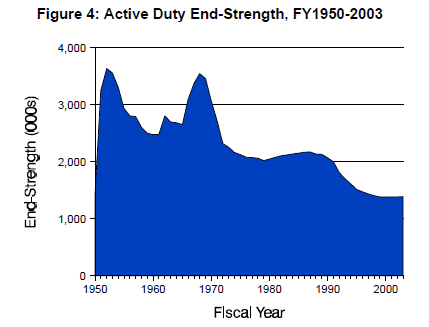
Active duty U.S. military personnel from 1950 to 2003; the two peaks correspond to the Korean War and the Vietnam War.
It is an all-volunteer military, but conscription through the Selective Service System can be enacted at the president's request and Congress' approval. All males ages 18 through 25 who are living in the United States are required to register with the Selective Service for a potential future draft.
The U.S. Armed Forces is the world's third largest military by active personnel, after the Chinese's People's Liberation Army and the Indian armed forces, and has troops deployed around the globe.
As in most militaries, members of the U.S. Armed Forces hold a rank, either that of officer, warrant officer or enlisted, to determine seniority and eligibility for promotion. Those who have served are known as veterans. Rank names may be different between services, but they are matched to each other by their corresponding paygrade.[35] Officers who hold the same rank or paygrade are distinguished by their date of rank to determine seniority, while officers who serve in certain positions of office of importance set by law, outrank all other officers in active duty of the same rank and paygrade, regardless of their date of rank.[36] In 2012, it was reported that only one in four persons in the United States of the proper age meet the moral, academic and physical standards for military service.[37]
By service
| Component | Military | Enlisted | Officer | Male | Female | Civilian |
| 471,513 | 376,206 | 90,785 | 465,784 | 69,345 | 299,644 | |
| 184,427 | 163,092 | 21,335 | 181,845 | 15,551 | 20,484 | |
| 325,802 | 267,286 | 54,114 | 265,852 | 62,168 | 179,293 | |
| 323,222 | 258,015 | 61,144 | 270,462 | 50,750 | 174,754 | |
| 42,042 | 32,782 | 8,239 | ||||
| Total Active | 1,347,106 | 1,137,916 | 236,826 | 1,219,510 | 210,485 | 681,232 |
| 336,879 | 291,865 | 45,014 | ||||
| 190,699 | 153,064 | 37,635 | ||||
| 38,473 | 34,079 | 4,394 | ||||
| 57,650 | 43,596 | 14,054 | ||||
| 106,549 | 91,274 | 15,275 | ||||
| 68,216 | 54,658 | 13,558 | ||||
| 6,142 | 5,086 | 1,056 | ||||
| Total Reserves | 807,562 | 673,622 | 130,986 | |||
| Other DoD personnel | 108,833 |
Stationing
Overseas

U.S. global military presence
As of 31 December 2010, U.S. Armed Forces troops were stationed in 150 countries; the number of non-contingent deployments per country ranges from 1 in Suriname to over 50,000 in Germany.[42] Some of the largest deployments are: 103,700 in Afghanistan, 52,440 in Germany *(*see list), 35,688 in Japan (USFJ), 28,500 in South Korea (USFK), 9,660 in Italy and 9,015 in the United Kingdom. These numbers change frequently due to the regular recall and deployment of units.
Altogether, 77,917 military personnel are located in Europe, 141 in the former Soviet Union, 47,236 in East Asia and the Pacific, 3,362 in North Africa, the Near East and South Asia, 1,355 in sub-Saharan Africa and 1,941 in the Western Hemisphere excluding the United States itself.
Domestic
Including U.S. territories and ships afloat within territorial waters As of 31 December 2009, a total of 1,137,568 personnel were on active duty within the United States and its territories (including 84,461 afloat).[43] The vast majority (941,629 personnel) were stationed at bases within the contiguous United States. There were an additional 37,245 in Hawaii and 20,450 in Alaska while 84,461 were at sea, 2,972 in Guam and 179 in Puerto Rico.
Types
Enlisted
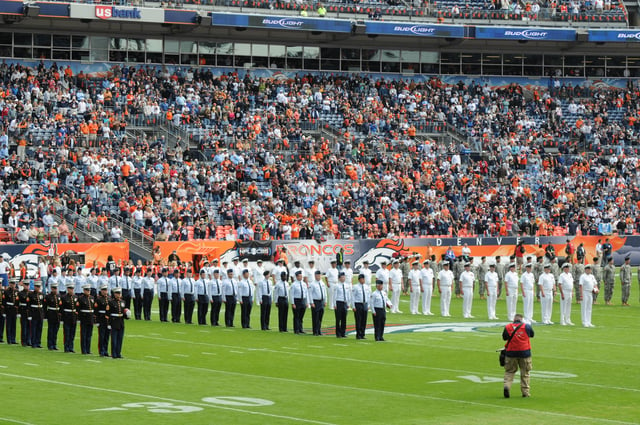
Service members of the U.S. Armed Forces at an American football event: (left to right) U.S. Marine Corps, U.S. Air Force, U.S. Navy and U.S. Army personnel
Prospective service members are often recruited from high school or college, the target age ranges being 18–35 in the Army, 18–28 in the Marine Corps, 18–34 in the Navy, 18–39 in the Air Force and 18–27 (up to age 32 if qualified for attending guaranteed "A" school) in the Coast Guard. With the permission of a parent or guardian, applicants can enlist at age 17 and participate in the Delayed Entry Program (DEP), in which the applicant is given the opportunity to participate in locally sponsored military activities, which can range from sports to competitions led by recruiters or other military liaisons (each recruiting station's DEP varies).
After enlistment, new recruits undergo basic training (also known as "boot camp" in the Marine Corps, Navy and Coast Guard), followed by schooling in their primary Military Occupational Specialty (MOS), rating and Air Force Specialty Code (AFSC) at any of the numerous training facilities around the United States. Each branch conducts basic training differently. The Marine Corps sends all non-infantry MOS's to an infantry skills course known as Marine Combat Training prior to their technical schools. Air Force Basic Military Training graduates attend Technical Training and are awarded their Air Force Specialty Code (AFSC) at the apprentice (3) skill level. All Army recruits undergo Basic Combat Training (BCT), followed by Advanced Individual Training (AIT), with the exceptions of cavalry scouts, infantry, armor, combat engineers and military police recruits who go to One Station Unit Training (OSUT), which combines BCT and AIT. The Navy sends its recruits to Recruit Training and then to "A" schools to earn a rating. The Coast Guard's recruits attend basic training and follow with an "A" school to earn a rating.
Initially, recruits without higher education or college degrees will hold the pay grade of E-1 and will be elevated to E-2 usually soon after basic training. Different services have different incentive programs for enlistees, such as higher initial ranks for college credit, being an Eagle Scout and referring friends who go on to enlist as well. Participation in DEP is one way recruits can achieve rank before their departure to basic training.
There are several different authorized pay grade advancement requirements in each junior-enlisted rank category (E-1 to E-3), which differ by service. Enlistees in the Army can attain the initial pay grade of E-4 (specialist) with a four-year degree, but the highest initial pay grade is usually E-3 (members of the Army Band program can expect to enter service at the grade of E-4). Promotion through the junior enlisted ranks occurs after serving for a specified number of years (which can be waived by the soldier's chain of command), a specified level of technical proficiency or maintenance of good conduct. Promotion can be denied with reason.
Non-commissioned and petty officers
With very few exceptions, becoming a non-commissioned officer (NCO) or petty officer in the U.S. Armed Forces is accomplished by progression through the lower enlisted ranks. However, unlike promotion through the lower enlisted tier, promotion to NCO is generally competitive. NCO ranks begin at E-4 or E-5, depending upon service and are generally attained between three and six years of service. Junior NCOs function as first-line supervisors and squad leaders, training the junior enlisted in their duties and guiding their career advancement.
While considered part of the non-commissioned officer corps by law, senior non-commissioned officers (SNCOs) referred to as chief petty officers in the Navy and Coast Guard, or staff non-commissioned officers in the Marine Corps, perform duties more focused on leadership rather than technical expertise. Promotion to the SNCO ranks, E-7 through E-9 (E-6 through E-9 in the Marine Corps) is highly competitive. Personnel totals at the pay grades of E-8 and E-9 are limited by federal law to 2.5 percent and 1 percent of a service's enlisted force, respectively. SNCOs act as leaders of small units and as staff. Some SNCOs manage programs at headquarters level and a select few wield responsibility at the highest levels of the military structure. Most unit commanders have a SNCO as an enlisted advisor. All SNCOs are expected to mentor junior commissioned officers as well as the enlisted in their duty sections. The typical enlistee can expect to attain SNCO rank after 10 to 16 years of service.
Senior enlisted advisors
Each of the five services employs a single senior enlisted advisor at departmental level. This individual is the highest ranking enlisted member within that respective service and functions as the chief advisor to the service secretary, service chief and Congress on matters concerning the enlisted force. These individuals carry responsibilities and protocol requirements equivalent to three-star general or flag officers. They are as follows:
Senior Enlisted Advisor to the Chairman
Sergeant Major of the Army
Sergeant Major of the Marine Corps
Master Chief Petty Officer of the Navy
Chief Master Sergeant of the Air Force
Master Chief Petty Officer of the Coast Guard
Warrant officers
Additionally, all services except for the Air Force have an active warrant officer corps. Above the rank of warrant officer one, these officers may also be commissioned, but usually serve in a more technical and specialized role within units. More recently, they can also serve in more traditional leadership roles associated with the more recognizable officer corps. With one notable exception (Army helicopter and fixed-wing pilots), these officers ordinarily have already been in the military often serving in senior NCO positions in the field in which they later serve as a warrant officer as a technical expert. Most Army pilots have served some enlisted time. It is also possible to enlist, complete basic training, go directly to the Warrant Officer Candidate School at Fort Rucker, Alabama and then on to flight school.
Warrant officers in the U.S. military garner the same customs and courtesies as commissioned officers. They may attend the officer's club, receive a command and are saluted by junior warrant officers and all enlisted service members.
The Air Force ceased to grant warrants in 1959 when the enlisted grades of E-8 and E-9 were created. Most non-flying duties performed by warrant officers in other services are instead performed by senior NCOs in the Air Force.
Commissioned officers
Officers receive a commission in one of the branches of the U.S. Armed Forces through one of the following routes.
Service academies (United States Military Academy (Army), United States Naval Academy, United States Air Force Academy, United States Coast Guard Academy and the United States Merchant Marine Academy)
Reserve Officers' Training Corps (ROTC)
Officer Candidate School (OCS) (Officer Training School (OTS) in the Air Force): this can be through active-duty schools, or through state-run schools in the case of the Army National Guard.
Direct commission: civilians who have special skills that are critical to sustaining military operations and supporting troops may receive direct commissions. These officers occupy leadership positions in law, medicine, dentistry, pharmacy, intelligence, supply-logistics-transportation, engineering, public affairs, chaplain, oceanography and others.
Battlefield commission: under certain conditions, enlisted personnel who have skills that separate them from their peers can become officers by direct commissioning of a commander so authorized to grant them. This type of commission is rarely granted and is reserved only for the most exceptional enlisted personnel; it is done on an ad hoc basis, typically only in wartime. No direct battlefield commissions have been awarded since the Vietnam War. The Navy and Air Force do not employ this commissioning path.
Limited Duty Officer: due to the highly technical nature of some officer billets, the Marine Corps, Navy and Coast Guard employ a system of promoting proven senior enlisted members to the ranks of commissioned officers. They fill a need that is similar to, but distinct from that filled by warrant officers (to the point where their accession is through the same school). While warrant officers remain technical experts, LDOs take on the role of a generalist, like that of officers commissioned through more traditional sources. LDOs are limited, not by their authority, but by the types of billets they are allowed to fill. However, in recent times they have come to be used more and more like their more-traditional counterparts.
Officers receive a commission assigning them to the officer corps from the president with the Senate's consent. To accept this commission, all officers must take an oath of office.
Through their careers, officers usually will receive further training at one or a number of the many staff colleges.
Company grade officers in pay grades O-1 through O-3 (known as "junior" officers in the Navy and Coast Guard) function as leaders of smaller units or sections of a unit, typically with an experienced SNCO (or CPO in the Navy and Coast Guard) assistant and mentor.
Field grade officers in pay grades O-4 through O-6 (known as "senior" officers in the Navy and Coast Guard) lead significantly larger and more complex operations, with gradually more competitive promotion requirements.
General officers, (known as flag officers in the Navy and Coast Guard) serve at the highest levels and oversee major portions of the military mission.
Chiefs of staff
Each service has a uniformed head who is considered the highest-ranking officer within their respective service, with the exception of the chairman and vice chairman of the Joint Chiefs of Staff, and the chief of the National Guard Bureau. They are responsible for ensuring personnel readiness, policy, planning and training and equipping their respective military services for the combatant commanders to utilize. They also serve as senior military advisors to the president, the secretary of defense, their respective service secretaries, as well as other councils they may be called to serve on. They are as follows:
Chief of Staff of the Army
Commandant of the Marine Corps
Chief of Naval Operations
Chief of Staff of the Air Force
Commandant of the Coast Guard
Five-star ranking
These are ranks of the highest honor and responsibility in the U.S. Armed Forces, but they are almost never given during peacetime and only a very small number of officers during wartime have held a five-star rank:
General of the Army
Fleet Admiral
General of the Air Force
No corresponding rank exists for the Marine Corps or the Coast Guard. As with three- and four-star ranks, Congress is the approving authority for a five-star rank confirmation.
The rank of general of the Armies is considered senior to general of the Army, but was never held by active duty officers at the same time as persons who held the rank of general of the Army. It has been held by two people: John J. Pershing who received the rank in 1919 after World War I and George Washington who received it posthumously in 1976 as part of the American Bicentennial celebrations. Pershing, appointed to General of the Armies in active duty status for life, was still alive at the time of the first five-star appointments during World War II and was thereby acknowledged as superior in grade by seniority to any World War II–era Generals of the Army. George Washington's appointment by Public Law 94-479 to General of the Armies of the United States was established by law as having "rank and precedence over all other grades of the Army, past or present", making him not only superior to Pershing, but superior to any grade in the Army in perpetuity.
In the Navy, the rank of admiral of the Navy theoretically corresponds to that of general of the Armies, though it was never held by active-duty officers at the same time as persons who held the rank of fleet admiral. George Dewey is the only person to have ever held this rank. After the establishment of the rank of fleet admiral in 1944, the Department of the Navy specified that the rank of fleet admiral was to be junior to the rank of admiral of the Navy. However, since Dewey died in 1917 before the establishment of the rank of fleet admiral, the six-star rank has not been totally confirmed.
Women
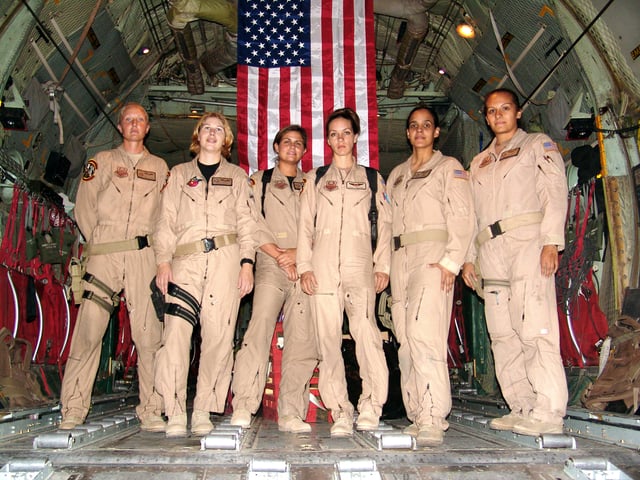
From 2005, the first all female C-130 Hercules crew to fly a combat mission for the U.S. Air Force[44]
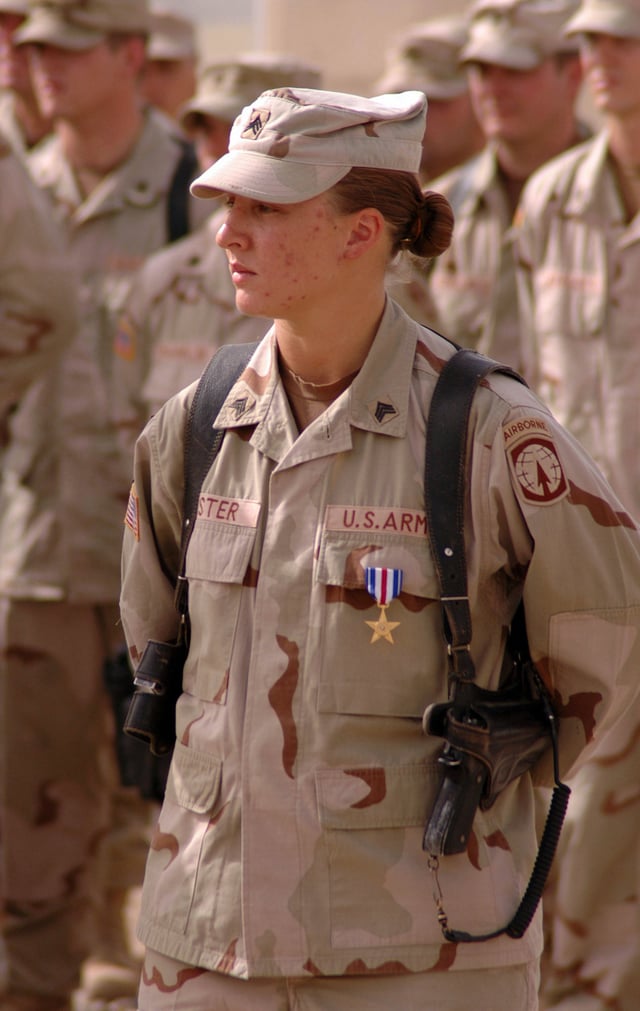
Sergeant Leigh Ann Hester, awarded the Silver Star for direct combat
The Woman's Army Auxiliary Corps was established in the United States in 1942. Women saw combat during World War II, first as nurses in the Pearl Harbor attacks on 7 December 1941. The Woman's Naval Reserve, Marine Corps Women's Reserve, US Coast Guard Women's Reserve, and Women Airforce Service Pilots (WASPs) were also created during this conflict. In 1944, WACs arrived in the Pacific and landed in Normandy on D-Day. During the war, 67 Army nurses and 16 Navy nurses were captured and spent three years as Japanese prisoners of war. There were 350,000 American women who served during World War II and 16 were killed in action. In total, they gained over 1,500 medals, citations and commendations. Virginia Hall, serving with the Office of Strategic Services, received the second-highest U.S. combat award, the Distinguished Service Cross, for action behind enemy lines in France.
After World War II, demobilization led to the vast majority of serving women being returned to civilian life. Law 625, The Women's Armed Services Act of 1948, was signed by President Truman, allowing women to serve in the U.S. Armed Forces in fully integrated units during peacetime, with only the WAC remaining a separate female unit. During the Korean War of 1950–1953, many women served in the Mobile Army Surgical Hospitals, with women serving in Korea numbering 120,000during the conflict. During the Vietnam War, 600 women served in the country as part of the Air Force, along with 500 members of the WAC and over 6,000 medical personnel and support staff. The Ordnance Corps began accepting female missile technicians in 1974[45] and female crewmembers and officers were accepted into Field Artillery missile units.[46][47]
In 1974, the first six women naval aviators earned their wings as Navy pilots. The congressionally mandated prohibition on women in combat places limitations on the pilots' advancement,[48] but at least two retired as captains.[49] In 1989, Captain Linda L. Bray, 29, became the first woman to command American soldiers in battle during the invasion of Panama. The 1991 Gulf War proved to be the pivotal time for the role of women in the U.S. Armed Forces to come to the attention of the world media; there are many reports of women engaging enemy forces during the conflict.[50]
In the 2000s, women can serve on U.S. combat ships, including in command roles. They are permitted to serve on submarines.[51] Women can fly military aircraft and make up 2% of all pilots in the U.S. Military. In 2003, Major Kim Campbell was awarded the Distinguished Flying Cross for landing her combat damaged A-10 Thunderbolt II with no hydraulic control and only one functional engine after being struck by hostile fire over Baghdad.
On 3 December 2015, U.S. defense secretary Ashton Carter announced that all military combat jobs would become available to women.[52] This gave women access to the roughly 10% of military jobs which were previously closed off due to their combat nature.[53] The decision gave military services until January 2016 to seek exceptions to the rule if they believe that certain jobs, such as machine gunners, should be restricted to men only.[54] These restrictions were due in part to prior studies which stated that mixed gender units are less capable in combat.[55] Physical requirements for all jobs remained unchanged, though.[55] Many women believe this will allow for them to improve their positions in the military, since most high-ranking officers start in combat positions. Since women are now available to work in any position in the military, female entry into the draft has been proposed.[56]
Sergeant Leigh Ann Hester became the first woman to receive the Silver Star, the third-highest U.S. decoration for valor, for direct participation in combat. In Afghanistan, Monica Lin Brown was presented the Silver Star for shielding wounded soldiers with her body.[57] In March 2012, the U.S. military had two women, Ann E. Dunwoody and Janet C. Wolfenbarger, with the rank of four-star general.[58][59] In 2016, Air Force General Lori Robinson became the first female officer to command a major Unified Combatant Command (USNORTHCOM) in the history of the United States Armed Forces.[60]
Despite concerns of a gender gap, all personnel both men and women at the same rank and time of service are compensated the same rate across all branches.[61]
A study conducted by the RAND Corporation also suggests that women who make the military their career see an improved rate of promotion, as they climb through the military ranks at a faster rate.[62]
Order of precedence
Under current Department of Defense regulation, the various components of the U.S. Armed Forces have a set order of seniority. Examples of the use of this system include the display of service flags, placement of soldiers, marines, sailors, airmen and coast guardsmen in formation, etc. When the Coast Guard shall operate as part of the Department of the Navy, United States Coast Guard Academy cadets, the United States Coast Guard and the Coast Guard Reserve shall take precedence after United States Naval Academy midshipmen; the United States Navy; and Navy Reserve, respectively.[63]
Cadets, U.S. Military Academy
Midshipmen, U.S. Naval Academy
Cadets, U.S. Coast Guard Academy (when part of the Department of the Navy)
Cadets, U.S. Air Force Academy
Cadets, U.S. Coast Guard Academy (when part of the Department of Homeland Security)
Midshipmen, U.S. Merchant Marine Academy
United States Army
United States Marine Corps
United States Navy
United States Coast Guard (when part of the Department of the Navy)
United States Air Force
United States Coast Guard (when part of Department of the Homeland Security)
Army National Guard of the United States
United States Army Reserve
United States Marine Corps Reserve
United States Navy Reserve
United States Coast Guard Reserve (when part of the Department of the Navy)
Air National Guard of the United States
United States Air Force Reserve
United States Coast Guard Reserve (when part of the Department of Homeland Security)
Other training and auxiliary organizations of the Army, Marine Corps, Merchant Marine, Civil Air Patrol and Coast Guard Auxiliary, as in the preceding order. The CAP was constituted through the Administrative Order 9 of 1 December 1941 and operated under the U.S. Army Air Forces during World War II. The CAP became the official civilian auxiliary of the newly independent USAF with the enactment of Public Law 80-557 on 26 May 1948.
Note: While the U.S. Navy is older than the Marine Corps,[64] the Marine Corps takes precedence due to previous inconsistencies in the Navy's birth date. The Marine Corps has recognized its observed birth date on a more consistent basis. The Second Continental Congress is considered to have established the Navy on 13 October 1775 by authorizing the purchase of ships, but did not actually pass the "Rules for the Regulation of the Navy of the United Colonies" until 27 November 1775.[65] The Marine Corps was established by act of said Congress on 10 November 1775. The Navy did not officially recognize 13 October 1775 as its birth date until 1972, when then–chief of naval operations Admiral Elmo Zumwalt authorized it to be observed as such.[64]
See also
Awards and decorations of the United States Armed Forces
Full-spectrum dominance
List of active United States military aircraft
List of currently active United States military land vehicles
List of currently active United States military watercraft
Military expression
Military justice
National Guard of the United States
Provisional Army of the United States
Public opinion of militaries
Servicemembers' Group Life Insurance
Sexual orientation and gender identity in the United States military
State Defense Force
Tricare – Health care plan for the U.S. uniformed services
United States military casualties of war
United States military veteran suicide
United States Space Force
Women in the United States Air Force
Women in the United States Army
Women in the United States Coast Guard
Women in the United States Marines
Women in the United States Navy